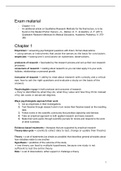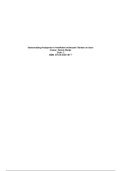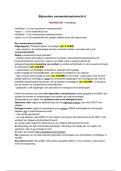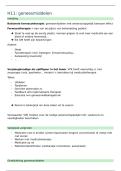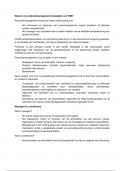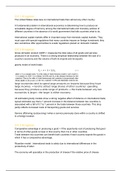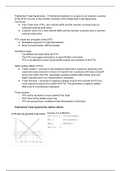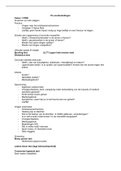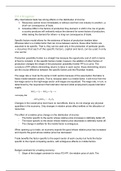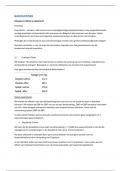- Chapter 1-14
- An additional article on Qualitative Research Methods for the final lecture, is to be
found on the Student Portal: Hanson, J.L., Balmer, D. F., & Giardino, A. P. (2011).
Qualitative Research Methods for Medical Educators. Academic Pediatrics,11:375–
386.
Chapter 1
Empiricism = answering psychological questions with direct, formal observations.
→ using senses or instruments that assist the senses as the basis for conclusions
empiricists → basing one’s conclusions on systematic observations.
producers of research = fascinated by the research process and set up their own research
processes.
consumers of research = reading about research so you can later apply it to your work,
hobbies, relationships or personal growth.
Consumer of research → ability to read about research with curiosity and a critical
eye; how to ask the right questions and evaluate a study on the basis of the
answers
Psychologists engage in both producer and consumer of research.
→ they’re identified by what they do, what they value and how they think instead
of by lab coats or advanced degrees.
Ways psychologists approach their work
1. Act as empiricists in their investigations
2. Test theories through research and in turn revise their theories based on the resulting
data
3. Follow norms in the scientific community that prioritize objectivity and fairness
4. Take an empirical approach to both applied research and basic research.
5. Make their work public through scientific journals for review and respond to the work
of other scientists.
Evidence-based treatments = therapies that are supported by empirical research
Theory-data cycle → scientists collect data to test, change or update their theories
Theory = a set of statements (as simple as possible) that describes general principles about
how variables relate to one another
Hypothesis = prediction of the outcome of the study
→ one theory can lead to multiple hypotheses, because one study is not
sufficient to test the entire theory.
Data = a set of observations; either support or challenge a theory
1
,Hypotheses are pre-registered → researcher states
publicly what the study’s outcome is expected to
be after the study is designed, but before
collecting any data.
Studies don’t prove theories, they support (are
consistent with) a theory.
→ a single confirming finding cannot prove a
theory
Replication = the study is conducted again to test
whether the result is consistent
Weight of the evidence = A conclusion drawn from reviewing scientific literature and
considering the proportion of studies that is consistent with a theory.
Falsifiability = a feature of a scientific theory, in which it is possible to collect data that will
indicate that the theory is wrong.
self-correcting = a process in which scientists make their research available for peer
review, replication and critique with the goal of identifying and correcting errors in the
research.
Four norms in the scientific community:
● Universalism = scientific claims are evaluated according to their merit, independent
of the researcher’s credentials or reputation. The same preestablished criteria apply
to all scientist and all research. (e.g. even a student can do science, no need for an
advanced degree)
● Communality = scientific knowledge is created by a community and its findings
belong to the community.
● Disinterestedness = Scientists strive to discover the truth, whatever it is; they are
not swayed by conviction, idealism, politics or profit.
● Organized skepticism = scientists question everything, including their own theories,
widely accepted ideas and “ancient wisdom.”
Applied, basic & translational research = research whose goal is to find a solution to a
particular real-world problem.
● applied → done with a practical problem in mind and the researchers
conduct their work in a local, real-world context
● basic research → to enhance the general body of knowledge rather than to
address a specific, practical problem
● translational research → the use of lessons from basic research to develop
and test applications to health care, psychotherapy or other forms of
treatment and intervention.
2
,Scientists want to tell the scientific world about their research results through writing a paper
and submitting it to a scientific journal. The articles are peer-reviewed, three or four
experts tell the editor about the work’s virtues and flaws. The editor then decides whether
the paper deserves to be published in the journal.
Journalism = news and commentary published in the popular media and produced for a
general audience.
3
, Chapter 2
Three sources of evidence for people’s beliefs: experience, intuition & authority
Comparison group → enables us to compare what would happen both with and
without the thing we are interested in.
Problems with personal experiences based conclusions:
- no comparison group
- when a change occurs, you don’t know what caused it
Confounds = a general term for a potential alternative explanation for a research finding; a
threat for internal validity
Confederate = an actor who is directed by the researcher to play a specific role in a
research study.
Probabilistic = describing the empirical method, stating that science is intended to explain a
certain proportion (but not necessarily all) of the possible cases.
Availability heuristic = guiding your thinking by what comes most easily to mind.
present/present bias = a bias in which people incorrectly estimate the relationship between
an event and its outcome, focusing on times the event and outcome are present, while failing
to consider evidence that is absent and harder to notice.
Confirmation bias = only believing what supports your belief.
Bias blind spot = the tendency for people to think that compared to others, they themselves
are less likely to engage in biased reasoning.
A concept map illustrating the sources of information reviewed in this chapter:
4


